adding oil CHEVROLET CAVALIER 1997 3.G Owners Manual
[x] Cancel search | Manufacturer: CHEVROLET, Model Year: 1997, Model line: CAVALIER, Model: CHEVROLET CAVALIER 1997 3.GPages: 388, PDF Size: 20 MB
Page 225 of 388
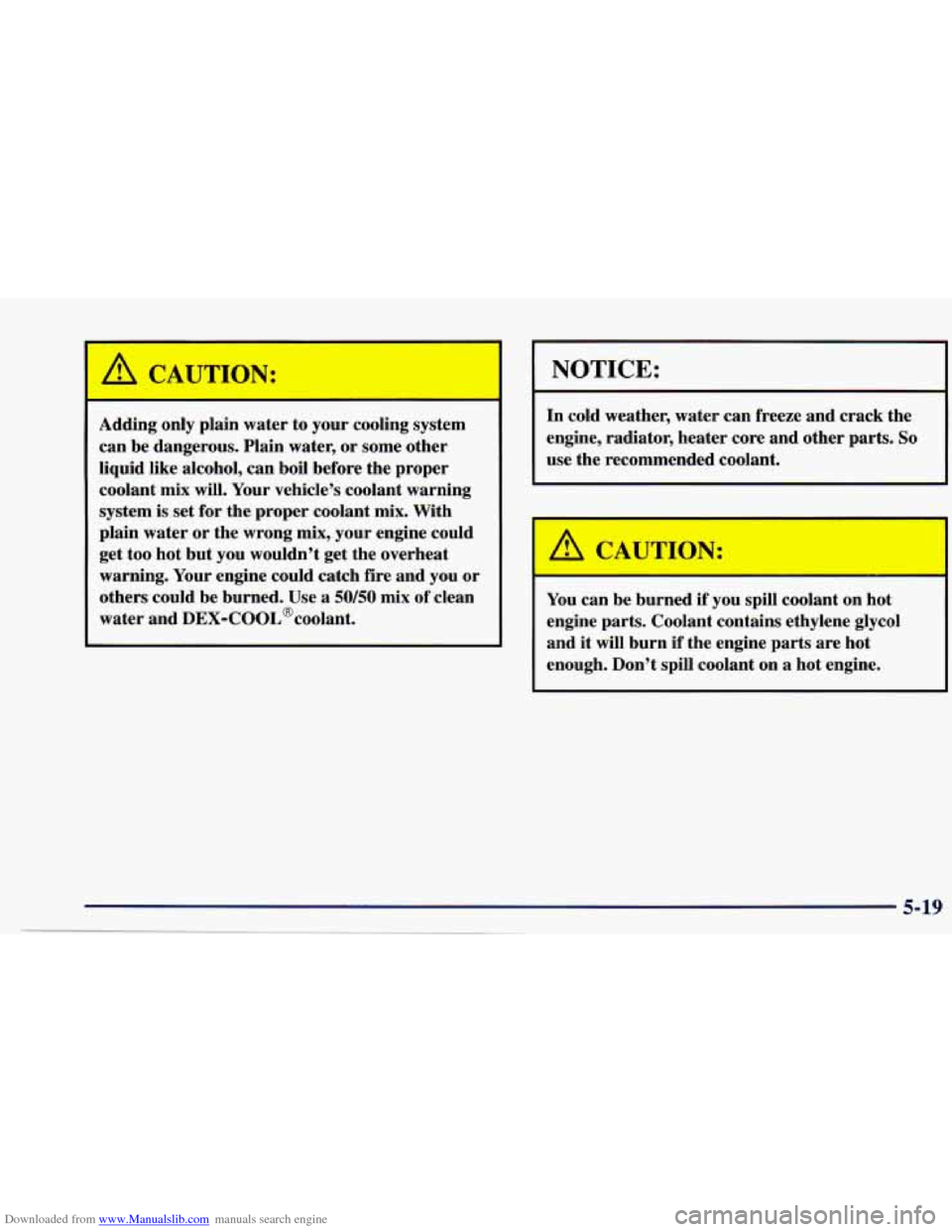
Downloaded from www.Manualslib.com manuals search engine A CAUTION:
Adding only plain water to your cooling system
can be dangerous. Plain water, or some other
liquid like alcohol, can boil before the proper
coolant mix
will. Your vehicle’s coolant warning
system is set for the proper coolant mix. With
plain water
or the wrong mix, your engine could
get too hot but you wouldn’t get the overheat
warning, Your engine could catch fire and you or
others could be burned. Use a
50/50 mix of clean
water and DEX-COOL@coolant.
NOTICE:
In cold weather, water can freeze and crack the
engine, radiator, heater core and other parts.
So
use the recommended coolant.
A CAUTION:
You can be burned if you spill coolant on hot
engine parts. Coolant contains ethylene glycol
and
it will burn if the engine parts are hot
enough. Don’t spill coolant on a hot engine.
Page 263 of 388
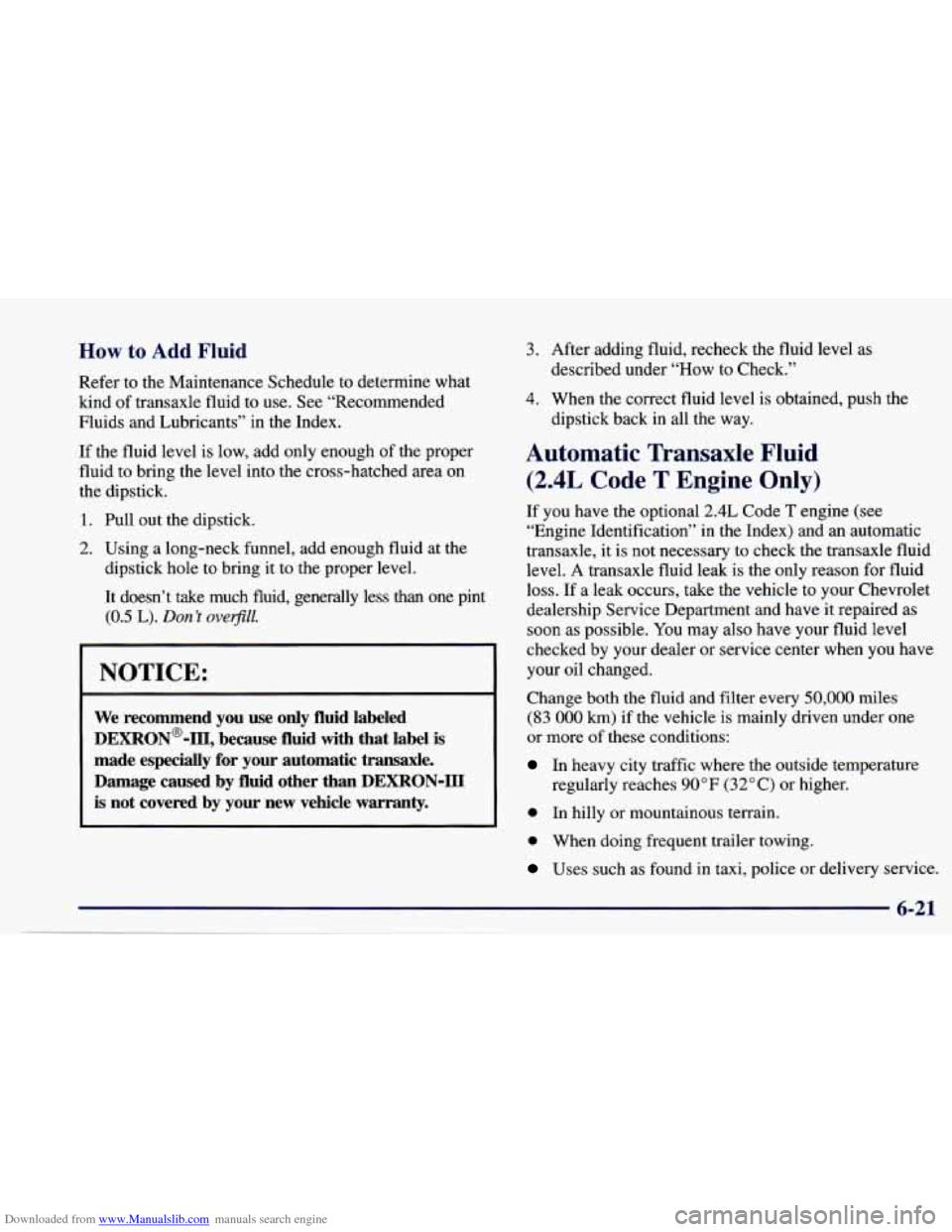
Downloaded from www.Manualslib.com manuals search engine How to Add Fluid
Refer to the Maintenance Schedule to determine what
kind
of transaxle fluid to use. See “Recommended
Fluids and Lubricants” in the Index.
If the fluid level is low, add only enough of the proper
fluid to bring the level into the cross-hatched area on
the dipstick.
1. Pull out the dipstick.
2. Using a long-neck funnel, add enough fluid at the
dipstick hole to bring it to the proper level.
It doesn’t
take much fluid, generally less than one pint
(0.5 L). Don’t ove@ll.
NOTICE:
We recommend you use only fluid labeled
DEXRON@-111, because fluid with that label
is
made especially for your automatic transaxle.
Damage caused by fluid other than DEXRON-III
is not covered by your new vehicle warranty.
3. After adding fluid, recheck the fluid level as
4. When the correct fluid level is obtained, push the
described
under “How to Check.”
dipstick back
in all the way.
Automatic Transaxle Fluid
(2.4L Code T Engine Only)
If you have the optional 2.4L Code T engine (see
“Engine Identification” in the Index) and an automatic
transaxle, it is not necessary to check the transaxle fluid
level.
A transaxle fluid leak is the only reason for fluid
loss.
If a leak occurs, take the vehicle to your Chevrolet
dealership Service Department and have it repaired as
soon as possible. You may also have your fluid level
checked by your dealer or service center when you have
your oil changed.
Change both the fluid and filter every
50,000 miles
(83 000 km) if the vehicle is mainly driven under one
or more
of these conditions:
In heavy city traffic where the outside temperature
0 In hilly or mountainous terrain.
0 When doing frequent trailer towing.
Uses such as found in taxi, police or delivery service.
regularly
reaches
90 OF (32 O C) or higher.
Page 267 of 388
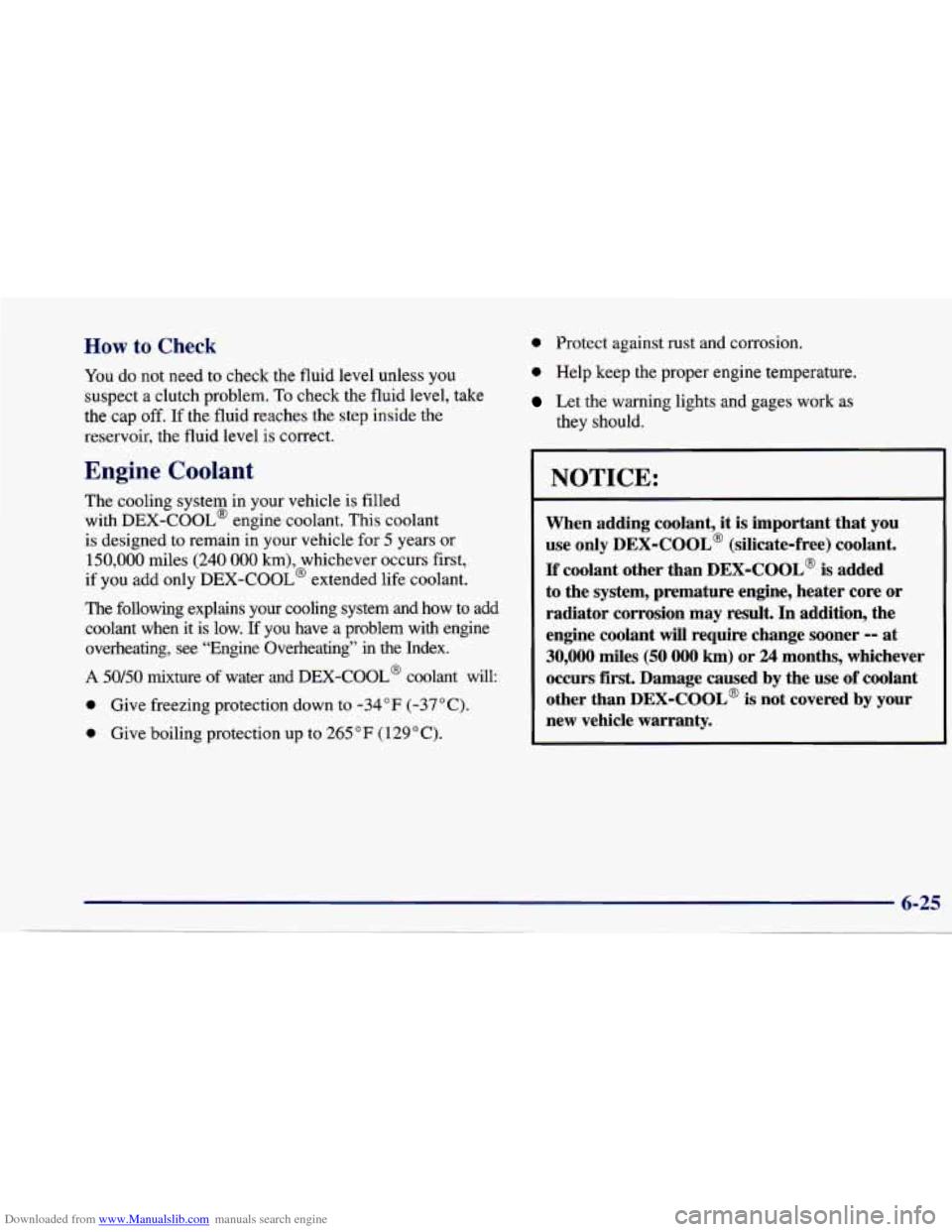
Downloaded from www.Manualslib.com manuals search engine How to Check
You do not need to check the fluid level unless you
suspect
a clutch problem. To check the fluid level, take
the cap
off. If the fluid reaches the step inside the
reservoir, the fluid level
is correct.
Engine Coolant
The cooling system in your vehicle is filled
with DEX-COOL@ engine coolant. This coolant
is designed to remain in your vehicle for
5 years or
150,000 miles (240 000 km), whichever occurs first,
if you add only DEX-COOL@ extended life coolant.
The following explains your cooling system and how to add
coolant when it is low.
If you have a problem with engine
overheating, see “Engine Overheating”
in the Index.
A 50/50 mixture of water and DEX-COOL@ coolant will:
0 Give freezing protection down to -34°F (-37°C).
0 Give boiling protection up to 265 “F (129°C).
0 Protect against rust and corrosion.
0 Help keep the proper engine temperature.
Let the warning lights and gages work as
they should.
NOTICE:
I
When adding coolant, it is important that you
use only
DEX-COOL@ (silicate-free) coolant.
If coolant other than
DEX-COOL’ is added
to the system, premature engine, heater core or
radiator corrosion may result. In addition, the
engine coolant will require change sooner
-- at
30,000 miles (50 000 km) or 24 months, whichever
occurs
first. Damage caused by the use of coolant
other than
DEX-COOL@ is not covered by your
new vehicle warranty.
Page 268 of 388
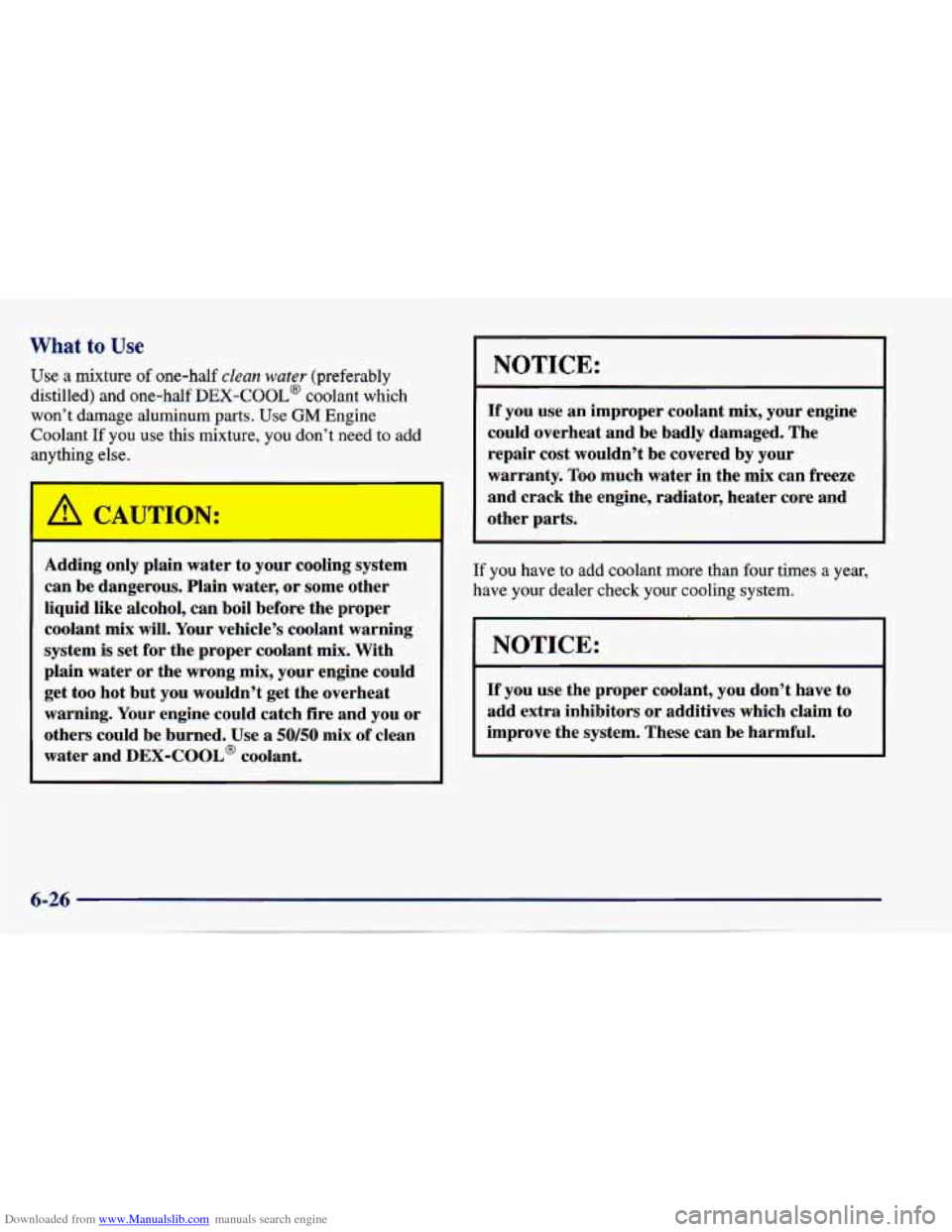
Downloaded from www.Manualslib.com manuals search engine What to Use
Use a mixture of one-half clean water (preferably
distilled) and one-half
DEX-COOL@ coolant which
won’t damage aluminum
parts. Use GM Engine
Coolant If you use this mixture, you don’t need to add
anything else.
Adding only plain water
to your cooling system
can be dangerous. Plain water, or some other
liquid like alcohol, can boil before the proper
coolant mix will. Your vehicle’s coolant warning
system is set for the proper coolant mix. With
plain water or the wrong mix, your engine could
get too hot but you wouldn’t get the overheat
warning. Your engine could catch fire and you
or
others could be burned. Use a 50/50 mix of clean
water and
DEX-COOL@ coolant.
NOTICE:
If you use an improper coolant mix, your engine
could overheat and be badly damaged. The
repair cost wouldn’t be
covered by your
warranty. Too much water in the mix can freeze
and crack the engine, radiator, heater core and
other parts.
[f you have to add coolant more than four times a year,
lave your dealer check your cooling system.
NOTICE:
If you use the proper coolant, you don’t have to
add extra inhibitors or additives which claim to
improve the system. These can be harmful.
Page 378 of 388
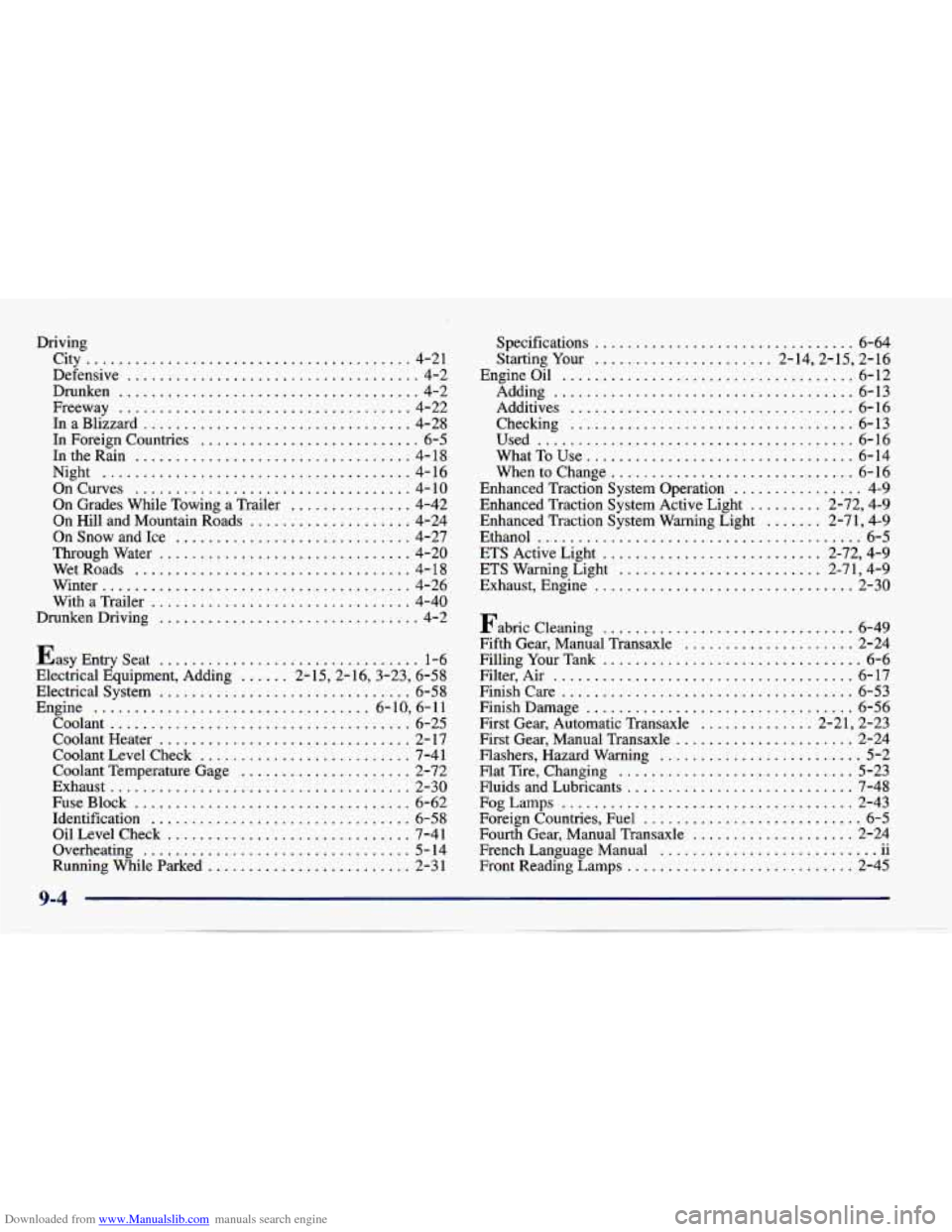
Downloaded from www.Manualslib.com manuals search engine Driving City
........................................ 4-21
Defensive
.................................... 4-2
Drunken
..................................... 4-2
Freeway
.................................... 4-22
InaBlizzard
................................. 4-28
In Foreign Countries
........................... 6-5
In the Rain
.................................. 4- 18
Night
...................................... 4-16
OnCurves
.................................. 4-10
On Grades While Towing a Trailer
............... 4-42
On Hill and Mountain Roads
.................... 4-24
OnSnowandIce
............................. 4-27
Throughwater
............................... 4-20
WetRoads
.................................. 4-18
Winter
...................................... 4-26
With a Trailer
................................ 4-40
DrunkenDriving
................................ 4-2
Easy Entry Seat ................................ 1-6
Electrical Equipment. Adding ...... 2-15.2-16.3-23. 6-58
Electrical System
............................... 6-58
Engine
.................................. 6-10. 6-11
Coolant
..................................... 6-25
Coolant Heater
............................... 2- 17
Coolant Level Check
.......................... 7-41
Coolant Temperature Gage
..................... 2-72
Exhaust
..................................... 2-30
Fuse Block
.................................. 6-62
Identification
................................ 6-58
OilLevelCheck
.............................. 7-41
Overheating
................................. 5-14
Running While Parked
......................... 2-31 Specifications
................................ 6-64
Starting Your
...................... 2.14.2.15. 2.16
Engineoil
.................................... 6-12
Adding
..................................... 6-13
Additives
................................... 6-16
Checking
................................... 6-13
Used
....................................... 6-16
What
To Use ................................. 6-14
When to Change
.............................. 6-16
Enhanced Traction System Operation
................ 4-9
Enhanced Traction System Active Light
......... 2.72. 4.9
Enhanced Traction System Warning Light
....... 2.71. 4.9
Ethanol
........................................ 6-5
ETS Active Light ........................... 2.72. 4.9
ETS Warning Light
......................... 2.71. 4.9
Exhaust. Engine
................................ 2-30
Fabric Cleaning
............................... 6-49
Fifth Gear. Manual Transaxle
..................... 2-24
Filling Your Tank ................................ 6-6
Filter. Air
..................................... 6-17
Finishcare
.................................... 6-53
Finish Damage
................................. 6-56
First Gear. Automatic Transaxle
.............. 2.21. 2.23
First Gear. Manual Transaxle
...................... 2-24
Flashers. Hazard Warning
......................... 5-2
Flat Tire. Changing
............................. 5-23
Fluids and Lubricants
............................ 7-48
FOgLmps
.................................... 2-43
Foreign Countries. Fuel
........................... 6-5
Fourth Gear. Manual Transaxle .................... 2-24
French Language Manual
11 1. ...........................
Front Reading Lamps ............................ 2-45